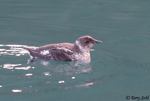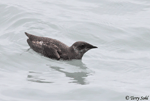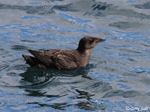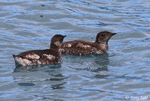| Length: 9.5 inches | Wingspan: 16 inches | Seasonality: Non-resident in South Dakota |
| ID Keys: In breeding plumage, dark brown with lighter speckling. Non-breeding birds generally black above, white below with white neck collar | ||
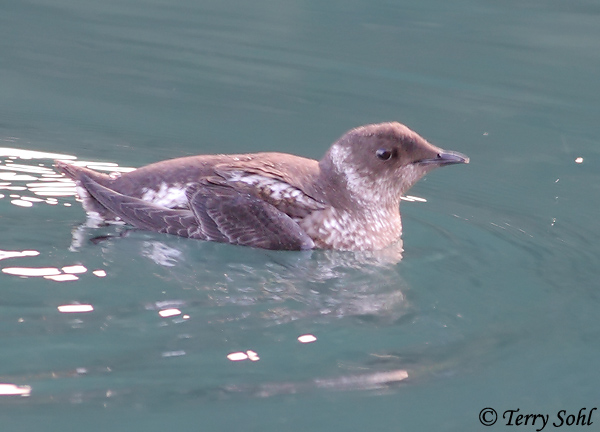 The Marbled
Murrelet is a small seabird of the north Pacific coast of North America.
They were one of the last birds in North America to have its nesting grounds
discovered, with the first nest not discovered until 1974. This is due to
their unusual nesting habits in much of their range, where the nest is built
high in the trees of very old-growth forest, sometimes many miles from the
coastline. Their dependence on old-growth forests for nesting has
undoubtedly resulted in declines in the species as logging has felled much
of their preferred nesting habitat. They have been listed as
"threatened" by U.S. Fish and Wildlife since 1992. Serious threats
continue to impact the species.
The Marbled
Murrelet is a small seabird of the north Pacific coast of North America.
They were one of the last birds in North America to have its nesting grounds
discovered, with the first nest not discovered until 1974. This is due to
their unusual nesting habits in much of their range, where the nest is built
high in the trees of very old-growth forest, sometimes many miles from the
coastline. Their dependence on old-growth forests for nesting has
undoubtedly resulted in declines in the species as logging has felled much
of their preferred nesting habitat. They have been listed as
"threatened" by U.S. Fish and Wildlife since 1992. Serious threats
continue to impact the species.
Habitat:
During the summer breeding season, breeds on mountainous slopes on the coast (typically on islands), or in mature, old-growth forest, sometimes well inland from the coast. At other seasons, found on protected waters near the coast.
Diet:
Feeds mostly on small fish and crustaceans such as shrimp and amphipods, as well as squid.
Behavior:
Forages by swimming underwater, usually in relatively shallow water close to shore.
Nesting:
The nest of a Marbled Murrelet is usually a simple depression in mosses and lichens on a sturdy tree branch, or in the northern portion of their range, the nest may be placed on the ground. Both males and females will help to incubate the eggs. Upon hatching, both parents tend to and feed the young.
Song:
The call of a Marbled Murrelet is a simple, clear keer note, occasionally uttered with two successive syllables. They also have other vocalizations in and around the nest.
1Click here to hear the call of a Marbled Murrelet, recorded near Sitka, Alaska
2Click here to hear the call of a Marbled Murrelet, recorded in British Columbia
Migration:
Many Marbled Murrelets stay very close to their summer breeding grounds in all seasons. However, there is some movement southward in the winter, as well as a greater likelihood that Marbled Murrelets will be found further from shore.
Interactive eBird Map:
Click here to access an interactive eBird map of Marbled Murrelet sightings
Similar Species:
Non-breeding birds are similar in appearance to nearly all other Murrelets in non-breeding plumage. Breeding plumage differences are easier to distinguish. Marbled Murrelets are most likely to be confused with the following species:
- Kittlitz's Murrelet - In breeding plumage, Kittlitz's Murrelets are lighter colored overall with more mottling on the back and head than a Marbled Murrelet. They also have a noticeably shorter bill. In non-breeding plumage, both have black and white plumages, but for a Kittlitz's Murrelet, the white is more extensive on the face and around the eyes, while on a Marbled Murrelet, the dark coloring on its head extends downward over the eyes.
- Long-billed Murrelet - In breeding plumage, the Long-billed Murrelet has a white throat, while the Marbled Murrelet has mottled underparts and throat. In non-breeding plumage, the black on the back of the neck of a Long-billed Murrelet is more consistent and extensive, while on a Common Murrelet, a white collar reaches almost to the back of the neck.
Conservation Status:
Marbled Murrelet are still common in some areas, but populations have plummeted in recent years, particularly in the southern part of their range. Habitat loss, vulnerability to oil spills, and the effects of climate change are significant threats to the species in the future. The IUCN currently lists the Marbled Murrelet as "Endangered".
Further Information:
1) U.S. Fish and Wildlife Profile - Marbled Murrelet
2) Audubon Guide - Marbled Murrelet
3) WhatBird - Marbled Murrelet
Photo Information:
Photo taken in August, 2010 - Resurrection Bay, off the coast of Seward, Alaska - Terry Sohl
Audio File Credits:
1Matt Goff, XC77418. Accessible at www.xeno-canto.org/77418.
2Ian Cruickshank, XC292891. Accessible at www.xeno-canto.org/292891
| Click below for a higher-resolution map |
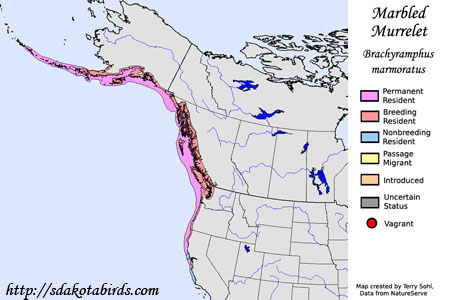 |
| South Dakota Status: Non-resident in South Dakota |
Additional Marbled Murrelet Photos
Click for a higher-resolution version of these photos
